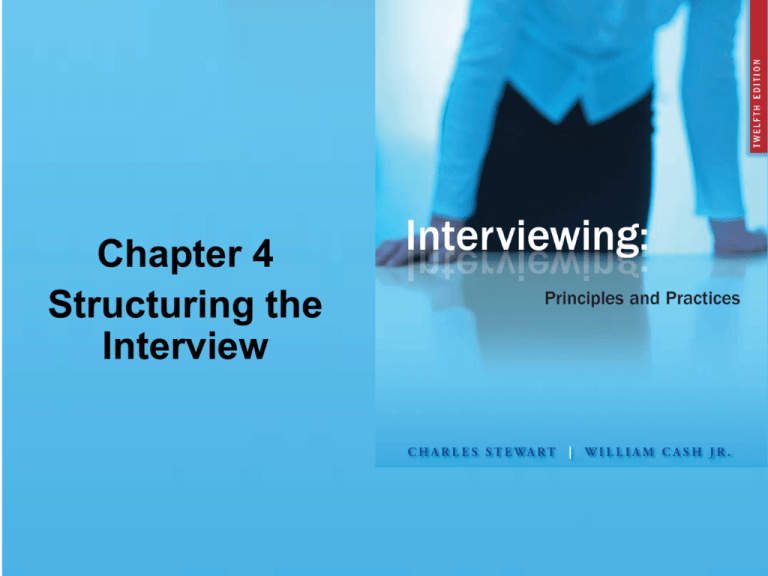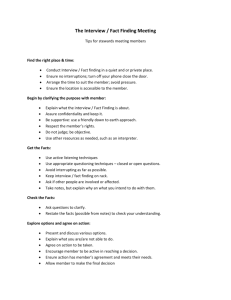
Chapter 4
Structuring the
Interview
Chapter Summary
Opening the Interview
The Body of the Interview
Closing the Interview
Summary
© 2009 The McGraw-Hill Companies, Inc. All rights reserved.
Opening the Interview
It takes two parties to launch an interview
successfully.
Two-Step Process
Establish rapport
Orienting the other party
Rapport and orientation are often intermixed
and reduce relational uncertainty.
© 2009 The McGraw-Hill Companies, Inc. All rights reserved.
The Body of the Interview
Interview Guide
An interview guide is a carefully structured outline
of topics and subtopics to be covered during an
interview.
A guide ensures the consideration of all important
topics and subtopics.
It assists in recording answers and recall at a later
date.
© 2009 The McGraw-Hill Companies, Inc. All rights reserved.
The Body of the Interview
Interview Guide
Outline Sequences
Topical
Time
Space
Cause-to-effect
Problem-solution
© 2009 The McGraw-Hill Companies, Inc. All rights reserved.
The Body of the Interview
Interview Schedules
A nonscheduled interview is merely an interview
guide with no questions prepared in advance.
Unintentional interviewer bias is most likely to
occur in a nonscheduled interview.
© 2009 The McGraw-Hill Companies, Inc. All rights reserved.
The Body of the Interview
Interview Schedules
A moderately scheduled interview contains all
major questions with possible probing questions
under each.
A moderately scheduled interview lessens the
dangers of instant question creation.
© 2009 The McGraw-Hill Companies, Inc. All rights reserved.
The Body of the Interview
Interview Schedules
A highly scheduled interview includes all
questions and the exact wording to be used with
each interviewee.
Highly scheduled interviews sacrifice flexibility
and adaptability for control.
© 2009 The McGraw-Hill Companies, Inc. All rights reserved.
The Body of the Interview
Interview Schedules
A highly scheduled standardized interview is
the most thoroughly planned and structured.
All question and answer options are stated in
identical words to each interviewee.
Highly scheduled standardized interviews are
necessary for precision, replicability, and
reliability.
© 2009 The McGraw-Hill Companies, Inc. All rights reserved.
The Body of the Interview
Interview Schedules
Consider a strategic combination of schedule
types.
Combined schedules enable interviewers to
satisfy multiple needs.
© 2009 The McGraw-Hill Companies, Inc. All rights reserved.
The Body of the Interview
© 2009 The McGraw-Hill Companies, Inc. All rights reserved.
The Body of the Interview
Question Sequences
Tunnel Sequence: A series of similar questions,
either open or closed. It works well with informal
and simple interviews.
Funnel Sequence: Begins with a broad, openended question and proceeds with evermore
restricted questions. It works well
with motivated interviewees.
© 2009 The McGraw-Hill Companies, Inc. All rights reserved.
The Body of the Interview
Question Sequences
Inverted Funnel Sequence: Begins with a closed question
and proceeds toward open questions. It provides a warmup time for those reluctant to talk.
Quintamensional Design Sequence: Five-step approach
that proceeds from an interviewee’s awareness of the issue
to attitudes uninfluenced by the interviewer, specific
attitudes, reasons for these attitudes, and intensity of
attitude. It is effective at assessing attitudes and beliefs
and is often used in opinion polls.
© 2009 The McGraw-Hill Companies, Inc. All rights reserved.
Closing the Interview
Take your time and be tactful in what you say
and do in the closing.
The closing often signals the continuation of
a relationship.
© 2009 The McGraw-Hill Companies, Inc. All rights reserved.
Closing the Interview
Functions and Guidelines for Closings
First, the closing signals the termination of the
interview but not the relationship.
Second, the closing may express supportiveness
to enhance the relationship and bring the
interview to a positive close.
Third, the closing may summarize the interview. A
summary must accurately reflect the important
elements of the interview.
© 2009 The McGraw-Hill Companies, Inc. All rights reserved.
Closing the Interview
Functions and Guidelines for Closings
Be sincere and honest.
Do not rush the closing.
Do not introduce new topics or ideas during the closing.
Leave the door open for future contacts.
Avoid false closings when the interview is not really over.
Avoid failed departures when you soon meet up again with
the party after having concluded the interview.
© 2009 The McGraw-Hill Companies, Inc. All rights reserved.
Closing the Interview
Closing Techniques
Offer to answer questions.
Use clearinghouse questions.
Declare completion of the intended purpose.
Make personal inquiries.
Make professional inquiries.
Signal that time is up.
Continued...
© 2009 The McGraw-Hill Companies, Inc. All rights reserved.
Closing the Interview
Closing Techniques
Explain the reason for the closing
Express appreciation or satisfaction
Arrange for the next meeting
Summarize the interview
© 2009 The McGraw-Hill Companies, Inc. All rights reserved.
Closing the Interview
Nonverbal Closing Actions
Plan the closing just as you do the opening and
body of the interview.
Combine effective verbal and nonverbal
techniques into effective closings.
© 2009 The McGraw-Hill Companies, Inc. All rights reserved.
Closing the Interview
Nonverbal Closing Actions
Common Nonverbal Closing Actions
Straightening up in your seat.
Leaning forward.
Standing up or moving away from the other party.
Uncrossing your legs.
Placing your hands on your knees as if preparing to
rise.
Continued...
© 2009 The McGraw-Hill Companies, Inc. All rights reserved.
Closing the Interview
Nonverbal Closing Actions
Common Nonverbal Closing Actions
Breaking eye contact.
Offering to shake hands.
Making hand movements.
Smiling.
Looking at a clock.
© 2009 The McGraw-Hill Companies, Inc. All rights reserved.
Summary
All three parts of each interview—opening,
body, and closing—are vital to its success.
The opening influences how both parties
perceive themselves and one another.
The body must be carefully structured with an
appropriate sequence that guides the
questions.
The closing not only brings the interview to
an end, but it may summarize information.
© 2009 The McGraw-Hill Companies, Inc. All rights reserved.








